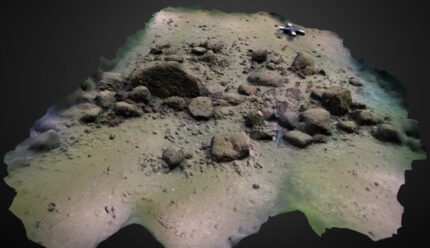
It is composed of 1,673 individual boulders placed next to each other for 971 meters along what was the shore of a lake before rising sea levels submerged it around 8,500 years ago. The deliberate alignment of the stones, the way smaller stones were used to connect larger three-foot boulders and the length of the wall indicates this was a megastructure built by Neolithic people, not a natural development caused by movement of glaciers.
The stones were first spotted by geologists investigating natural formations of manganese crusts on the seabed of Mecklenburg Bay in 2021. They reported the find to the Mecklenburg-Western Pomerania State Office for Culture and Monument Preservation who arranged for a team of multi-disciplinary researchers to investigate the structure. They used submersibles to collected sediment samples, created a detailed 3D model of the wall from geophysical data and dove the site to explore the wall close-up.
From the sediment samples, researchers were able to date construction to around 11,000 years ago in the early Mesolithic period. It was built by hunter-gatherers who inhabited the area and was likely a drive lane (a means to control the movement of animals to force them into a restricted space or, in this case, the lake itself) used to hunt migrating Eurasian reindeer. Prehistoric stone walls like these have been found elsewhere in the world (Jordan, Canada, Saudi Arabia, Greenland, the United States) but are all but unknown in Europe. The closest comparable example was found at the bottom of Lake Huron in Michigan where a stone wall was used to hunt migrating caribou 9,000 years ago. It is much shorter a wall than the Mecklenburg megastructure — 98 feet versus 3186 feet.
The stone wall and the surrounding seabed will be investigated in more detail using side-scan sonar, sediment echo sounder and multibeam echo sounder devices. Additionally, research divers from the University of Rostock and archaeologists from the LAKD M-V are planning further diving campaigns to search the stone wall and its surroundings for archaeological finds that could help with the interpretation of the structure.
Luminescence dating, which can be used to determine when the surface of a stone was last exposed to sunlight, may help in determining a more precise date that the stone wall was constructed. Furthermore, the researchers intend to reconstruct the ancient surrounding landscape in more detail.
“We have evidence for the existence of comparable stone walls at other locations in the Mecklenburg Bight. These will be systematically investigated as well,” explains Jens Schneider von Deimling from Kiel University.
The study has been published in the Proceedings of the National Academy of Sciences and can be read here.
* This article was originally published here








No comments:
Post a Comment